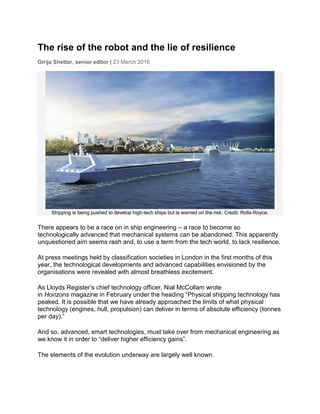
The rise of the robot and the lie of resilience
- 1. The rise of the robot and the lie of resilience Girija Shettar, senior editor | 23 March 2016 Shipping is being pushed to develop high-tech ships but is warned on the risk. Credit: Rolls-Royce. There appears to be a race on in ship engineering – a race to become so technologically advanced that mechanical systems can be abandoned. This apparently unquestioned aim seems rash and, to use a term from the tech world, to lack resilience. At press meetings held by classification societies in London in the first months of this year, the technological developments and advanced capabilities envisioned by the organisations were revealed with almost breathless excitement. As Lloyds Register’s chief technology officer, Nial McCollam wrote in Horizons magazine in February under the heading “Physical shipping technology has peaked. It is possible that we have already approached the limits of what physical technology (engines, hull, propulsion) can deliver in terms of absolute efficiency (tonnes per day).” And so, advanced, smart technologies, must take over from mechanical engineering as we know it in order to “deliver higher efficiency gains”. The elements of the evolution underway are largely well known.
- 2. Ships will have multiple sensors enabling connectivity on board between the ship’s systems as well as between the ship and shore side; autonomous systems and remote handling; nanotechnologies for advanced materials, advanced components and systems, and ultimately artificial intelligence; drones for inspections; virtual design systems; seafarer training simulators; and big data, that assists in design, manufacturing, maintenance, operation, and when analysed can help to predict and plan future required actions, to achieve increased safety, efficiency and reduced costs. The phrase ‘increased safety, efficiency and reduced costs’, tends to inspire a compliant response. But is industry being forced to comply in a movement that it should be questioning? It is not only shipping, road and rail transport that are being pulled along. Critical infrastructures, globally, are targeted. Millions of dollars are being poured into developing and connecting services, including: food, water, energy, transport, telecoms, healthcare, and the built environment. Millions are also being spent on special projects that will then build resilience into those advanced tech networks to reduce risk and, purportedly, make the fabric of society safer, as can be read about in the booklet Foresight review of Resilience from the Lloyd's Register Foundation, which is supporting this among several related initiatives. The funding for these projects stems from multiple government and privately funded interests, such as the US Department of Homeland Security, the Rockefeller Foundation, the UN Office for Disaster Risk Reduction, and the UK’s Engineering and Physical Sciences Research Council. A reportedly unmoved shipping industry is often warned, at regularly convened cyber security meetings, to guard against the risks as ships become increasingly cyber- enabled. Let’s take cloud storage. As data generated by systems increases exponentially in order to serve the demand for greater efficiency needs, more and more storage space is needed. Data servers are needed so that clients can access the information they store in the cloud, and these data servers may use different power supplies in case one of the power supplies goes down. Ultimately, however, all power supplies are vulnerable, as are data servers and computers: losing any of these would mean losing access to the data.
- 3. Some also fear for data ownership in the cloud. Data could get lost in cloud storage and thus potentially everyone’s data could become accessible to everyone else: virtual chaos triggering a physical one. While people and businesses only trust their data to a company if security measures are in place, such as encryption, authentication, and authorisation, even with these in place there are risks. Hackers have demonstrated this to us time and time again. Physical machines of course can be stolen; and in the case of business a disgruntled employee can alter, steal, leak or destroy company data. The risks associated with unmanned ships, or even highly connected ships, are well known. The ease with which hackers can get into systems means that they could take control and turn ships into weapons or, through creating collisions and groundings, self- destructors. There is also the risk that unchecked development will push out smaller shipping businesses, leaving sea trade in the hands of a few large players. And if the big players went down, they would take other service-related businesses with them, including sea trade itself. There is also the risk that costs will spiral upwards. High tech is smart, fast and complex. For example, cyber security officers can already be outgunned by the number of attacks a company system receives and ideally need more specialised software to help them manage those attacks effectively. So, can cyber-enabled infrastructure be considered safe? The experts say: no. At a recent maritime cyber security meeting, Rick Driscoll, vice- president for satellite products at communications firm KVH, warned that since “on land, it is impossible to be 100% protected against cyber risks”, establishing “contingency plans and following cyber safety measures” will give ships a “higher level of protection”. But a “higher level of protection” is not total protection. How can protection come from within – and be a part of – a flawed system? If cyber-enabled infrastructure cannot be “100% safe”, why are millions of dollars being unquestioningly poured into it, and why is industry being driven to spend millions when this could ultimately prove wholly destructive? Instead of artificial intelligence, the industry should shrewdly consider its sources of human intelligence and take this race only as far as it is comfortable.